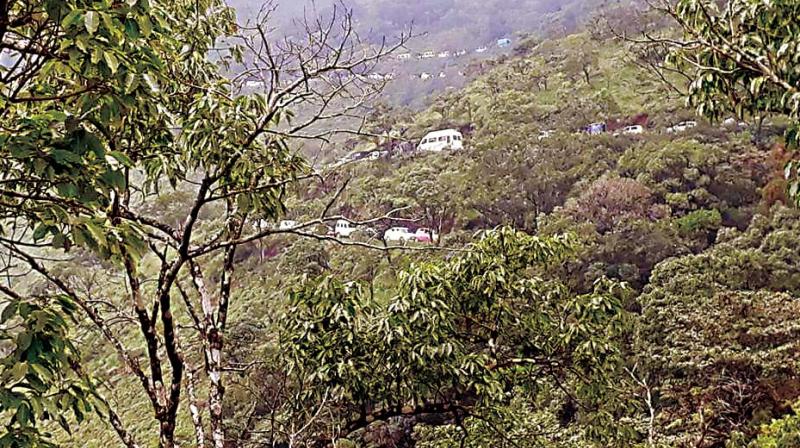After the drought, deluge & the green derangement
Post the Kodagu deluge of 2018, the Geological Survey of India did a survey,of almost all 150 locations that were visited by landslides.

Kodagu is at the crossroads with two successive years of unprecedented landslides and rains leaving every Kodava battling the uncomfortable question - is the tourism boom with more hotels and swanky resorts to rake in the big bucks worth it, if it means cutting into the pristine hills, destroying lush green forests nurtured over a thousand years and inviting the wrath of nature in the form of devastating natural calamities? As the picturesque district and its hardy people pick up the broken pieces of their lives and embark on the painful journey of rehabilitation, VINAY MADHAV finds out why the process of development has taken an unexpected and maybe undesirable detour and if anything can be done to reclaim the dream destination of every nature lover.
Home to lush green cover and rivers running down hillsides , the Western Ghats are a balmy retreat for most looking to get away from their busy city lives. But this very fact appears to have been their undoing. With hordes of tourists descending on the ghats, they have seen resorts and homestays mushroom on the hills over the years and as roads and bridges followed, the damage was complete.
The first indication that all was not well came on August 14, 2018, when heavy rain lashed northern Kodagu, leading to unprecedented landslides that submerged villages like Kaluru, Madpura, Makkanduru and the slopes of Mandalpatti under tonnes of mud and slush, leaving many dead and even more homeless.
But even before the district authorities could rebuild the devastated region and fully rehabilitate those who had lost their homes in the deluge, the disaster was repeated this August, this time in southern Kodagu, where the heavy monsoon led to floods and landslides, once again claiming lives and burying houses under mud and boulders, leaving many homeless.
While the landslide in Thora village near Virajpet, was not severe, the bigger problem worrying its people is the crack developing on the Ayyappa hill nearby, which is threatening to destroy half the town, should it cave in.
Worse, this year landslides were seen all along the ghats, stretching beyond Kodagu to neighbouring Hassan, Chikkamagalur, Shivamogga and Uttara Kannada. While Mudigere taluk in Chikkamagaluru district was the worst affected in terms of loss of life and property, the devastation of the last two years has exposed the vulnerability of the formidable Western Ghats, where rivers that are a lifeline of the state, originate.
Post the Kodagu deluge of 2018, the Geological Survey of India did a survey,of almost all 150 locations that were visited by landslides. The committee headed by GSI director, K.V. Maruthi, categorically blamed human interference and large scale deforestation in 38 villages in the affected districts for them. “The roads have been constructed in an unscientific fashion by bulldozing hills. Hills have also been destroyed for construction of houses, hotels, resorts, home stays and coffee plantations. The act has caused damage to the natural landscape of the region. The severely damaged hills collapsed when the flood water gushed in and modern amenities built on the hills have triggered a huge scale disaster,'' the report said in a strong indictment of official carelessness in preserving one of the most valuable biodiversity hotspots of the country.
It also made several recommendations to be followed whenever any developmental or restoration work is carried out in the Western Ghats. But the sum and substance of the report is that there has been steady and unscientific land use contributing to systematic degeneration of the Western Ghats, starting from Kodagu to Belagavi, bordering Goa and Maharashtra as evident from the fact that this year the Chorla ghat, connecting Karnataka and Goa also saw landslides.
While the changes like buildings, roads, bridges and other infrastructure projects are visible, there have been invisible changes too over the years that are messing with the ghats' fragile ecology.
Over the last two decades, with cattle slowly vanishing from the area and the locals turning to dairy milk, the grasslands and shrubs have been converted into coffee estates. Paddy fields too have given way to arecanut and coffee plantations in many parts as the crop has proved financially unviable for farmers. With the coffee plantations taking over, the traditional jungle trees are systematically being replaced by fast growing trees like silver oak. The arecanut plantations too have their own problems related to land use change.
While in the past, the combination of traditional trees, grasslands and paddy fields played a vital role in striking an ecological balance in this high rainfall region, their gradual disappearance has now made the ghats vulnerable to landslides and floods.
Between Kodagu and Sringeri in Chikkamagaluru district, the area is predominantly under coffee, pepper, cardamom and arecanut plantations and paddy fields. And from Sringeri to Belagavi, arecanut, paddy and other commercial crops dominate.
Noted a technical report by the Institute of Engineers, Mysuru after the 2018 deluge around Madikeri, “An environment that was stable for millions of years was destroyed through deforestation, levelling of the hills for agriculture, cutting of slopes for roads or building construction.”
Moreover, while tourism has generated employment and boosted incomes here over the last decade, it has also led to construction of hotels, resorts and home stays, and conversion of estates into multiple small plots, which are sold to people from cities. The plots that are used to build houses are most in demand on the slopes, where their owners can have a good view of the valley.
The construction of roads and bridges which followed, has also exerted pressure on the ghats. During the 2018 deluge, the landslide at Madapura was triggered by construction of multiple ponds along the natural course of a natural on a hillside. Two of the five ponds breached, increasing the magnitude of the landslide.
Human pressure has worked in other ways to. With no one bothering to study the carrying capacity of the hills, thousands of people are allowed to descend on them, causing kilometer long traffic jams with no law to regulate this mad rush or contain the behaviour of tourists.
The problem is only aggravated by encroachments. With not much awareness about who operates Kodagu’s 36 different land tenures, those that do not come under the forest department have become easy targets for encroachers. In other parts of the Western Ghats, there is lack of clarity on the demarcation of land between the revenue and forest departments, which makes it vulnerable to encroachment too. The government hardly intervenes as it is allegedly afraid of “vote polarisation.”
Despite the facts staring them in the face, government officials and locals here seem to be living in denial mode. They point to the silver oaks and coffee plantations to prove that the ghats have not lost their green cover and cite the economic growth of the region to claim that all is well. But when a natural catastrophe strikes the entire economy of the region is wiped out as the last two years have demonstrated.
While Kodagu has an average economy of around Rs 1,200 crore per year in terms of commercial crops, the 2018 deluge reduced it to around Rs 800 crore and this year, it is expected to fall further to around Rs 600 crore.
Chikkamagaluru,which earns around Rs 3000 crore from commercial crops, is likely to see it reduced by 50 per cent following the landslides and floods and this applies to the entire ghat region. Even more alarming is that no seems sure how the courses of the rivers that originate in the Western Ghats are going to be affected following the recent disastrous monsoons. Also, the soil that slid down the hills could take decades to restore.
The writing then is clearly visible on the wall for all to see: Unless immediate and strict measures are taken to correct things, the ecology of the sensitive Western Ghats could be in serious trouble in years to come.

